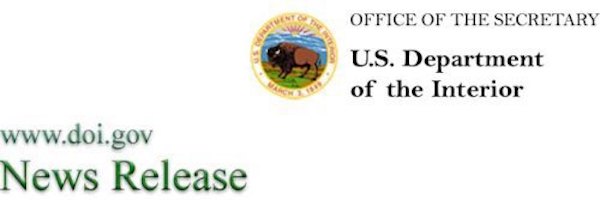Share Secretary Bernhardt Announces $10.7 Million in Public-Private Support for Big Game Migration Corridors
by DOI
5-3-2019
Website
WASHINGTON – Today, U.S. Secretary of the Interior David Bernhardt announced the award of $2.1 million in grants to state and local partners in Colorado, Montana, Nevada, Utah, Washington, and Wyoming for habitat conservation activities in migration corridors and winter range for elk, mule deer, and pronghorn. The targeted big game species will benefit from the conservation actions funded by these grants as will a wide array of plant and other wildlife species.
Through a public-private partnership between the Department of the Interior (DOI), the National Fish and Wildlife Foundation (NFWF), and ConocoPhillips, the grants are expected to leverage more than $8.6 million in matching contributions, generating a total conservation impact of more than $10.7 million. The announcement comes as Secretarial Order 3362 is implemented to improve the habitat conditions in big game migration corridors and winter range areas.
“We're thrilled to have effectively leveraged limited grant funding to accomplish meaningful conservation for wildlife," said Secretary Bernhardt. “Working in a collaborative and cooperative fashion with states, landowners, tribes, and partners who are committed to actual on-the-ground habitat conservation projects is the best approach to support a wide variety of voluntary habitat conservation activities.”
“The epic migrations of elk, mule deer and other large mammals in North America is one of nature’s most spectacular phenomena, often involving vast herds of wildlife traveling 100 miles or more between wintering grounds and summer habitats,” said Jeff Trandahl, executive director and CEO of NFWF. “But these iconic animals face ever-increasing impediments to movement from highways, residential development, fencing and other factors. Working with the Department of the Interior and private-sector partners such as ConocoPhillips, NFWF has been able to fund vital conservation projects at migratory bottlenecks and linkages that must be conserved to ensure healthy populations of these iconic animals.”
“For over 100 years, ConocoPhillips has invested in efforts to protect species and the critical habitats that are vital components to ecological balance and environmental sustainability,” said Ryan M. Lance, chairman and chief executive officer of ConocoPhillips. “Understanding and tracking animal movements is crucial for conserving habitats that are essential to species survival. Through our partnership with NFWF and the DOI, we are proud to support this year’s Big Game Migration grant recipients and their efforts to improve critical habitats and migration corridors for these animals.”
The grants represent the first round of awards from the “Improving Habitat Quality in Western Big Game Winter Range and Migration Corridors” competitive grant program. This new public-private partnership was created to enhance and improve habitats on winter ranges, stopover areas and migration corridors used by big game species, both on federal lands and private lands whose owners volunteer to participate in conservation efforts.
Examples of projects that will received grants include:
• In Colorado, the state Department of Transportation will work with the Southern Ute Tribe and Colorado Parks and Wildlife to install wildlife fencing to direct mule deer, elk, and other wildlife to a either an overpass or underpass on U.S. Highway 160 between Durango and Pagosa Springs. This project will increase connectivity and maintain a significant corridor for the respective deer and elk herds while reducing mortality for these species and improving motorist safety.
• In Nevada, the Rocky Mountain Elk Foundation will help secure 2,100 acres along the base of the Ruby Mountains and a migration route for the state’s largest herd of mule deer. Additionally, the easement will improve the habitat connectivity between U.S. Forest Service and U.S. Bureau of Land Management administered lands benefiting a multitude of species. A second project by the Nevada Department of Wildlife will restore 2,500 acres of sagebrush in critical mule deer winter range after catastrophic fires destroyed much of the habitat in recent years. This effort is important to re-establish sagebrush and avoid conversion of the landscape to invasive cheatgrass.
• In Montana, the Ranchers Stewardship Alliance, Inc. will work with a wide range of partners and in a completely voluntary manner with private landowners to improve or modify fencing in corridor areas. Additionally, the Montana Partners for Fish and Wildlife will work with a ranch in the Big Hole Valley by conducting a variety of habitat improvement projects that will benefit pronghorn, elk, mule deer, moose and greater sage-grouse.
Eligible applicants for the program include non-profit 501(c) organizations, U.S. Federal government agencies, state government agencies, local governments, municipal governments, and Indian tribes. For more information about how to apply for this grant, please visit https://www.nfwf.org/westernmigrations.
More Reports

3-28-2019
Yesterday, U.S. Acting Secretary of the Interior David Bernhardt signed a secretarial order to establish a Departmental task force to...... Read More
